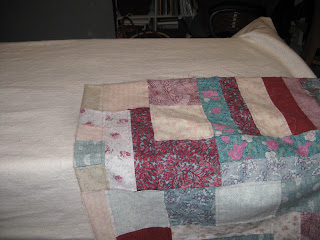The Mom Cave has gotten a little out of control recently. Between finishing taxes and rearranging a bit, things got stacked instead of sorted and stored. To the left though, you can see the new work table arrangement. The craft table is now standing on a set of drawers to raise it by 10 inches, which puts it just about right for working while standing. If anything, it might be about an inch too tall. But as I'm planning to use it for basting and arranging, not cutting and pressing it should work out in the long run. I may add a few more drawers underneath it to better utilize the storage space. Eventually the remote was found, not under a stack of fabric as I expected, but under the sewing desk.
Step 2: Insert appropriate movie.
Tonight's choice - Love Actually, starring Colin Firth, Hugh Grant, Kiera Knigtly, Liam Neeson, Alan Rickman and Emma Thompson among others. A stellar cast and one of my favorites. Not, however, a household favorite.
Step 2: Start pressing and cutting.
I spent the evening pressing and cutting the white muslin and navy backing for the batting samples. The objective is a fourteen inch square for the front and a half white/half navy for the backing. In an effort to best match my samples, I limited my cutting to the first 9 sets as I have two different cuts of white muslin and I'm pretty sure they are from different lots. Each cut was halved and one half washed, the other set aside.
I don't have a 14 inch square ruler - so I used two rulers side by side - a 6.5 x 24.5 inch ruler is butted against the 10.5 inch square. I first measured 7.5 inches in from the end using the square and added the additional 6.5 inches. For the half strips the same procedure was used to add the extra inch for the 7.5 inch cut. (The blue painters tape is left over from a previous exercise in squaring blocks - I used it as a visual reminder for the measurements.)
Step 4: Mark the center boxes.
The next step was to mark a 6 inch square in the center of the block. This center block will be used as a baseline to measure shrinkage as a result of quilting density. It will again be used as a gauge to measure how much overall shrinkage there is from washing. The Gingher cutting mat has shaded squares in the center of it, which if you squint really hard are barely visible in the picture.
I used the shaded area as a guide for placing a 6.5 inch square ruler and traced the square using a pigma pen. I first traced the top and right side of the square. I then used the lines on the Omnigrid ruler to correctly place the ruler for the left and bottom lines.
The prewashed sets each have a P in one corner. Once I sandwich the blocks, I'll also number each sample block according to whichever batting is in each. The lines and letter P have been heat set. After quilting and the initial measurement of shrinkage, I'll stitch along the square and the block ID in case of fading in the wash. I learned from the signature quilt, that using starch on signature blocks carries a risk of fading. And there is a lot of starch on this fabric as the wrinkles on the pre-washed set were very well set. The unwashed set still has the original sizing in it, so there may be a risk of fading on those blocks as well.
Next step is to pin the blocks - and pair them up. At that point, I'll have plenty of samples ready for practicing free-motion quilting.







































